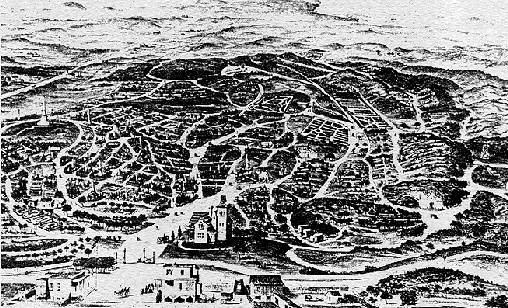Old Cemeteries in the City
Laurel Heights Cemetery during the 1890s, sprawling into the sand dunes of the Inner Richmond area.
1850s: Early San Francisco Cemeteries: Mission Dolores. Russian Hill. Telegraph Hill. North Beach, Yerba Buena, and Presidio.
1854: Laurel Hill Cemetery developed.
Late 1850s: Yerba Buena Cemetery abandoned.
1860: Calvary Cemetery, the Catholic Cemetery, developed on Lone Mountain.
1864: Masonic Cemetery developed.
1865: Odd Fellows Cemetery developed.
1880s: The cry "Remove the cemeteries!" began.
1900: Most graveyards filled. Cemeteries deteriorating.
1902: Ordinance Number 8108 prohibited burials within the city.
1921: State legislation passed to allow cemeteries to be abandoned. Litigation followed.
1923: Second Morris Act passed allowing removal of bodies from cemeteries.
1920s: Masonic and Odd Fellows Cemeteries' remains removed to Colma.
1920s: "Franciscan Heights" subdivision developed on Odd Fellows land. University of San Francisco purchased Masonic cemetery land. Jordan Park developed.
1927: St. Ignatius College moved to Fulton and Parker Streets.
1930: St. Ignatius renamed the University of San Francisco.
1930s: Removal of Laurel Hill and Calvary encouraged. Several plans discussed but had little support.
1932: San Francisco College for Women built on Lone Mountain.
1937: Catholic Archdiocese ceased opposition to removal of Calvary.
1930s/1940s: Removal of Laurel Hill and Calvary remains to Colma.
1940s/1950s: Development of Laurel Heights with residential homes and apartments.
1964: University of San Francisco became co-educational.
1978: University of San Francisco acquired Lone Mountain campus.
1980s: Columbarium renovated under ownership of Neptune Society.
1988: St. Ignatius High School torn down. Koret Recreational Center built.
Contributors to this page include:
Gaar Collection,San Francisco,CA - Publisher or Photographer

